Gigabyte GA-Z77X-UD5H Review: Functionality meets Competitive Pricing
by Ian Cutress on July 25, 2012 5:00 AM EST- Posted in
- Motherboards
- Gigabyte
- Z77
3D Movement Algorithm Test
The algorithms in 3DPM employ both uniform random number generation or normal distribution random number generation, and vary in various amounts of trigonometric operations, conditional statements, generation and rejection, fused operations, etc. The benchmark runs through six algorithms for a specified number of particles and steps, and calculates the speed of each algorithm, then sums them all for a final score. This is an example of a real world situation that a computational scientist may find themselves in, rather than a pure synthetic benchmark. The benchmark is also parallel between particles simulated, and we test the single thread performance as well as the multi-threaded performance.
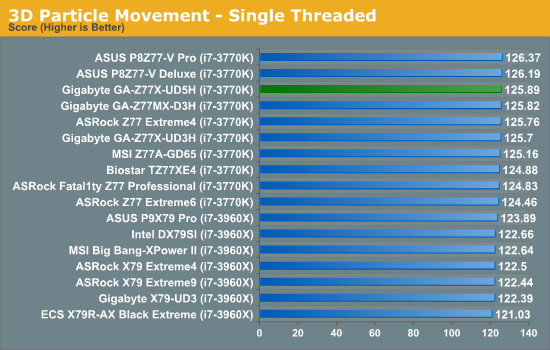
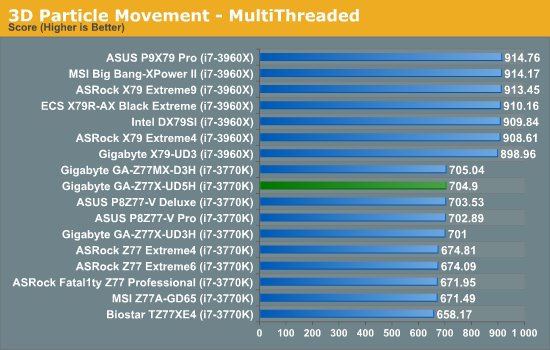
The Z77X-UD5H takes advantage of MultiCore Enhancement, which gives the system the full turbo CPU mode no matter the loading. This gives the motherboard competitive pace in our multithreaded testing, but also single threaded testing is almost at the top.
WinRAR x64 3.93 - link
With 64-bit WinRAR, we compress the set of files used in the USB speed tests. WinRAR x64 3.93 attempts to use multithreading when possible, and provides as a good test for when a system has variable threaded load. If a system has multiple speeds to invoke at different loading, the switching between those speeds will determine how well the system will do.

Gigabyte show that their CPU multiplier response to variable threaded loads is good, taking the top two spots in our WinRAR testing - the Z77X-UD5H coming joint second with 174 seconds.
FastStone Image Viewer 4.2 - link
FastStone Image Viewer is a free piece of software I have been using for quite a few years now. It allows quick viewing of flat images, as well as resizing, changing color depth, adding simple text or simple filters. It also has a bulk image conversion tool, which we use here. The software currently operates only in single-thread mode, which should change in later versions of the software. For this test, we convert a series of 170 files, of various resolutions, dimensions and types (of a total size of 163MB), all to the .gif format of 640x480 dimensions.
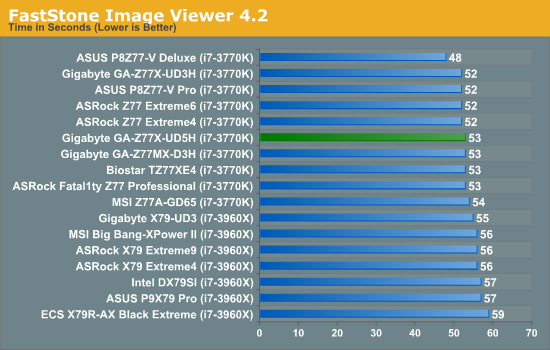
In our single threaded FastStone test, The Gigabyte Z77X-UD5H joins the majority of our Z77 boards in the low 50-second region.
Xilisoft Video Converter
With XVC, users can convert any type of normal video to any compatible format for smartphones, tablets and other devices. By default, it uses all available threads on the system, and in the presence of appropriate graphics cards, can utilize CUDA for NVIDIA GPUs as well as AMD APP for AMD GPUs. For this test, we use a set of 32 HD videos, each lasting 30 seconds, and convert them from 1080p to an iPod H.264 video format using just the CPU. The time taken to convert these videos gives us our result.
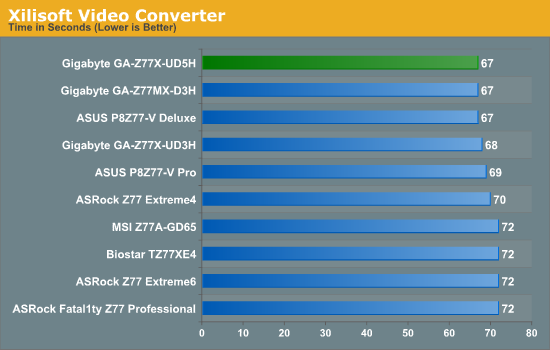
As XVC is a fully multithreaded test, the extra speed the Gigabyte gets from enabling MultiCore Enhancement results in a joint-top time score of 67 seconds.
x264 HD Benchmark
The x264 HD Benchmark uses a common HD encoding tool to process an HD MPEG2 source at 1280x720 at 3963 Kbps. This test represents a standardized result which can be compared across other reviews, and is dependant on both CPU power and memory speed. The benchmark performs a 2-pass encode, and the results shown are the average of each pass performed four times.
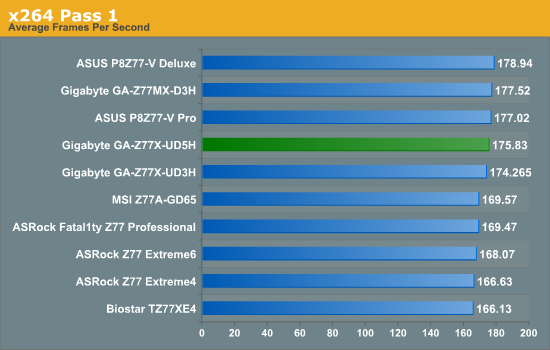
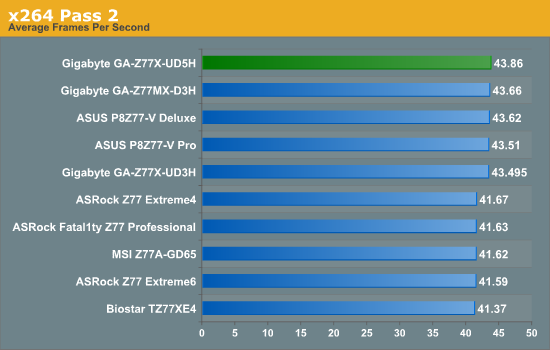
Again, the Z77X-UD5H comes near top with the extra MHz under multi-threaded load.










70 Comments
View All Comments
IanCutress - Wednesday, July 25, 2012 - link
As a competitive overclocker, I have used GBTL when pushing the BCLK of these boards as far as my CPU will allow (http://hwbot.org/submission/2301438_). I like GBTL - no mess and no fuss. But it is understandable why they do not include it in the Support CD, and hence why it doesn't really get a mention here. I did touch upon it very briefly in the overclocking section of the Z77X-UD3H review back at Ivy launch. As for voltage read-points, they are mentioned briefly in the board features, but I am also in agreement that perhaps the implementation of other manufacturers is more beneficial in our very niche usage scenario :)Ian
PS On the multi-board reviews I try not to take anything out from what is in a single board review. Every benchmark, test and bit of analysis in each of them gets put in :)
Nickel020 - Wednesday, July 25, 2012 - link
Oh, I missed the part about the GBTL in the UD3H review. While I haven't goten around to playing with my UD3H, I have found the Asus AI suite very practical for "normal" overclocking and I believe the GBTL will also be a real benefit for anyone working out a good 24/7 overclock. If I didn't knwo about it already I certainly would want to read about in your review if I was going to get this board for 24/7 OC.I also missed you mentioning the UD3Hs voltage read points, but in any case there's still an error in the conclusion though where you implicitly state that the UD3H does not have voltage read points (in the part about the GD65).
I know you run the same benchmarks, but I find the text/user experience more interesting than the benches, and there's definitely more text in a single board review! The benches I only care about to see whether a board has a significant performance issue, since I'm not into competitive OC I don't care about slight differences that I won't notice anyway.
Conderning the benches, I'm also a little surprised that you somewhat praise GB for auto-overclocking the CPU. IIRC Anandtech has been opposed to that in the past, since it's technically overclocking and thus theoretically voids your CPU warranty. It also makes it hard to compare board performance when CPU settings are actually the same, such as when using a manual overclock. I know it's considerably more work, but I would love to see the benches with the CPU forced to run at stock settings added to the charts, the current version is an apples to oranges comparison imho. For someone just looking at the charts (and not the text, as many do...) the current ones give a very wrong impression, they make it seem like Asus and GB perform better, when without the auto-overclock, they might actually be worse...
IanCutress - Wednesday, July 25, 2012 - link
Most users of these boards never touch the BIOS, let alone update it. This is why we run the boards at default - some manufacturers are being more aggressive with their settings and that is what you are paying for. If that aggressive setting compromises stability, then that can also be an issue. Thus it is a like-for-like comparison, as if a user was taking the boards out of the box and then just strapping in a CPU.After all, if we start changing the application of Turbo modes, what else do we change? Setting the voltage equal on each board to get a VMM reading that is always the same across the range? How about disregarding any board that uses x8/x4/x4 PCIe 3.0 against x8/x8/x4 PCIe 2.0? Default is the choice because that's what most users will end up with. Visiting some LANs recently, you would be surprised how many people buy 2133+ kits of memory and not enable XMP. That's the reality of it.
I used to be wary of this feature (as per my review of the P9X79 Pro, where I disabled it and was severely disgruntled), and still am as it results in motherboard manufacturers artificially inflating some results as to what you would expect. But this did happen before in earlier chipsets, when one manufacturer would run 100.5 BCLK, and the next would use 101.3, and even 102 BCLK, stating 'that's just how the design works'.
There's nothing we can do to change this, so I am taking the position of sitting back and analysing what they are doing, and how aggressive they are taking this philosophy. Any good reviewer will recognise what is pure statistical variation and not assign world class status to a result that is 0.01% difference.
With regards the warranty, it is a tough hammer to nail down. Would a pair of companies ever advertise that by default their settings technically breaches warranty? Or how would Intel take it, given that technically none of the cores ever went past the top turbo mode? Without a direct response on the issue, it's not worth speculating. I've known users to repeatedly successfully RMA CPUs they've overclocked on LN2 way too hard and broke them, so we don't really know if Intel will draw a line much.
Nickel020 - Thursday, July 26, 2012 - link
It's certainly a matter of opinion. As an "enthusiast" I'm of the opinion that a board should not overclock without my knowledge/express wish (since I can easily do so myself. Practically the overclock of course has no bearing on CPU warranty (the CPU also being the very last PC component that you're likely to need warranty on...).I agree that for the average user this is actually added value, a slight performance bonus at absolutely no cost other than a little bit more power consumption. Maybe point out both sides in future reviews? That way everyone's happy :)
PS: Please do fix the error in the UD3H, GD65 conclusion, it's wearing me down ;)
http://www.anandtech.com/show/5793/intel-z77-mothe...
"For the price we lose PCI and mSATA over the Gigabyte, but gain SATA, voltage read points, [...]" <--- wrong, maybe say "better implemented voltage read points"? ;)
Nickel020 - Thursday, July 26, 2012 - link
Thanks Ian :)mystikl - Wednesday, July 25, 2012 - link
No VGA port, no floppy connector, no buy .Dustin Sklavos - Wednesday, July 25, 2012 - link
Seriously?First, it does have a VGA port. Why you would want to use one escapes me now, but it's there.
Second...you still need a floppy drive and can't make do with a USB 2.0 one? Almost no modern motherboards include floppy connectors because floppy disks are horrendously outdated and that real estate can be better employed elsewhere.
mystikl - Wednesday, July 25, 2012 - link
I was actually making fun of the guy who posted the second comment! Why on earth people still need those ancient connectors is beyond me. Some may argue that some ancient software doesn't run without that specific port, but software that old doesn't require a computer with a quad core, 16 GB RAM and 3 videocards.shin0bi272 - Wednesday, July 25, 2012 - link
bios flashes on some boards still require a floppy disk... even on a quad core.SodaAnt - Wednesday, July 25, 2012 - link
Luckily those boards have floppy ports then.